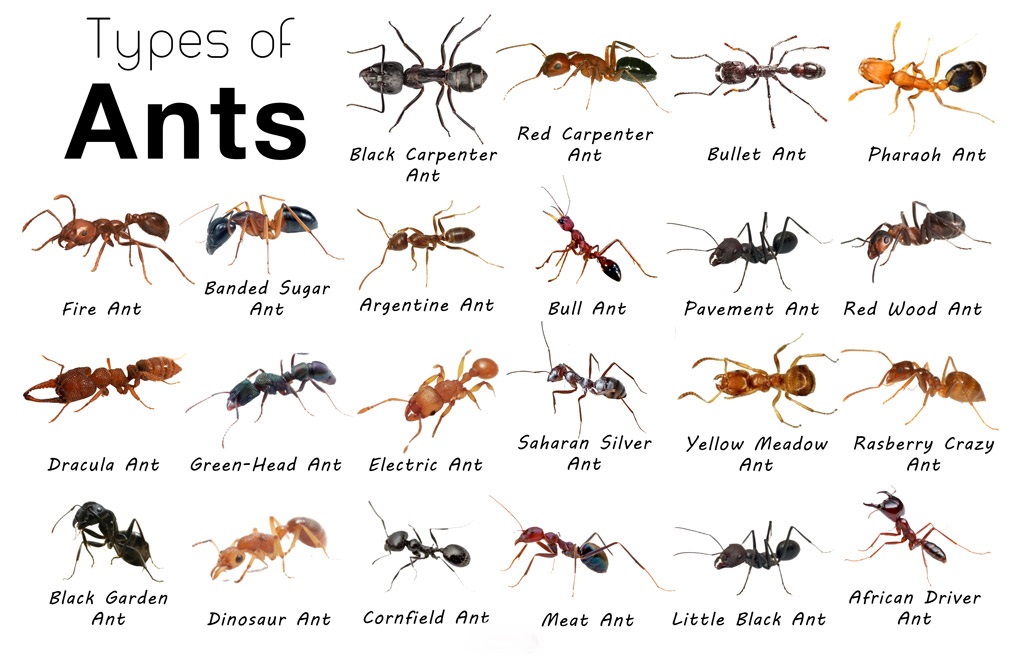Ants, belonging to the family Formicidae, are highly social, small insects recognized by their distinctive antennae and slender, node-like waists. These tiny creatures live in well-organized colonies, which can house millions of individuals depending on the species. Colonies typically consist of sterile female workers and soldiers, fertile males, and one or more queens, each playing a specific role within the colony.
Scientific Classification of Ants
- Kingdom: Animalia
- Phylum: Arthropoda
- Class: Insecta
- Order: Hymenoptera
- Family: Formicidae

Common Types of Ant Species
There are over 12,000 classified ant species, with estimates suggesting around 22,000 species in total. Here are some commonly found species:
- Acrobat ant
- Argentine ant
- Asian needle ant
- Carpenter ant
- Crazy ant
- Dark rover ant
- European fire ant
- Field ant
- Odorous house ant
- Pavement ant
- Pharaoh ant
- Thief ant
- Red imported fire ant
- Leaf-cutting ant
- Sugar ant
- Harvester ant
- Black house ant
- Little black ant
- Red wood ant
- Black garden ant
- Driver ant
- Atta ant
- Bullet ant
- Yellow meadow ant
- Weaver ant
- Electric ant
- Meat ant
- Saharan silver ant
- Subterranean ant
Total number of species mentioned: 29
Physical Description and Appearance
- Size: Ants range in size from 0.75 mm to 52 mm (0.030 – 2.0 inches). The largest species, Titanomyrma giganteum, can reach a length of 6 cm (2.4 in) with a wingspan of up to 15 cm (5.9 in).
- Color: Most ants are either black or red, although some species are green, and tropical ants may have a metallic sheen.
Body Structure:
- Head: Equipped with compound eyes, three ocelli (simple eyes), a pair of antennae, and powerful mandibles.
- Exoskeleton: The hard outer shell protects the ant and serves as an anchor for its muscles.
- Mesosoma (Thorax): This part of the body holds the legs and wings.
- Metasoma (Abdomen): Contains the respiratory, excretory, and reproductive organs.
- Legs and Wings: Ants have six legs with hooked claws for climbing. Only reproductive ants (queens and males) have wings.
Global Distribution and Habitat
Ants are found on every continent except Antarctica, thriving in nearly every type of environment. However, islands like Iceland, Greenland, the Hawaiian Islands, and some parts of Polynesia lack native ant species.
Ant habitats vary widely; some ants burrow underground, others build mounds at ground level, while a few species construct nests in trees or wood.
Lifespan of Ants
- Queens: Can live for up to 30 years.
- Workers and Soldiers: Typically live 1-3 years.
- Males: Have a short lifespan, often living only a few weeks.
Diet and Feeding Habits
Ants are omnivores, feeding on a wide range of foods including meats, seeds, fruits, fungus, and sugary liquids like nectar. They are also known to hunt other insects, such as termites.
Ant Behavior and Social Structure
Ants communicate through sounds, touch, and pheromones. They use their antennae to detect scents, and some species utilize a variety of defense mechanisms, such as biting or stinging and injecting chemicals like formic acid.
Key Behavioral Traits:
- Tandem Running: Experienced foragers lead others to new food sources, teaching them the route.
- Symbiosis: Some ants, like leafcutter ants, rely on microbial partners to digest food more effectively.
- Nesting: Ants build nests in a variety of locations such as underground, within tree trunks, and under stones.
- Foraging: Some species, such as the Sahara desert ant, rely on internal navigation systems to find their way back to the nest.
Adaptations
- Elbowed Antennae: Ants’ antennae help them sense vibrations, air currents, and chemicals.
- Mandibles: Strong jaws are used for carrying food, manipulating objects, and defense.
- Specialized Navigation: Some species, like the Sahara desert ant, can count steps and use the sun’s position for direction.
Reproduction and Mating
Ant reproduction is typically carried out by the queen and breeding females called “gamergates.” Mating occurs during a nuptial flight, typically in late spring or early summer. After mating, the queen finds a suitable place to establish a new colony.
Life Cycle
Ants undergo complete metamorphosis. After mating, the queen lays fertilized eggs that hatch into worker ants and unfertilized eggs that become male drones. The larvae are cared for by the worker ants, who feed them through trophallaxis (mouth-to-mouth feeding).
Frequently Asked Questions
- Do ants sleep?
Yes, ants have rest periods, with queens sleeping up to 9 hours daily and workers taking shorter naps. - How many ants are in the world?
The global ant population exceeds 100 trillion ants. - How much can an ant lift?
Depending on the species, ants can carry 20-5,000 times their body weight. - Do ants have brains?
Yes, ants have small brains with around 250,000 brain cells. - Do ants feel pain?
Ants do not feel pain, though they can sense injury and react to it.
Interesting Facts
- Ant colonies are often called “superorganisms” because the colony functions as a single unit.
- Ants are capable of hibernation in colder climates.
- Weaver ants are used in biological control for citrus crops.
- Trap-jaw ants have some of the fastest mandibles in the insect world.
ant species, types of ants, ant behavior, ant reproduction, social ants, ant nests, common ants, world’s largest ant, ant lifespan, ant diet, ant habitats, ant facts, ant communication
